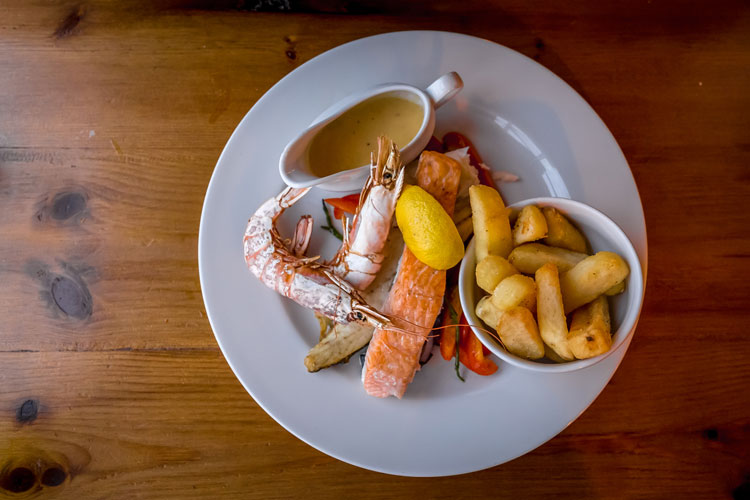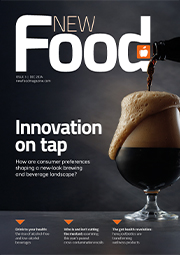Falling back in love with seafood
- Like
- Digg
- Del
- Tumblr
- VKontakte
- Buffer
- Love This
- Odnoklassniki
- Meneame
- Blogger
- Amazon
- Yahoo Mail
- Gmail
- AOL
- Newsvine
- HackerNews
- Evernote
- MySpace
- Mail.ru
- Viadeo
- Line
- Comments
- Yummly
- SMS
- Viber
- Telegram
- Subscribe
- Skype
- Facebook Messenger
- Kakao
- LiveJournal
- Yammer
- Edgar
- Fintel
- Mix
- Instapaper
- Copy Link
Posted: 21 November 2018 | Richard Watson | No comments yet
Richard Watson of Seafish assesses the current picture in terms of how seafood is performing in the retail market, what consumers are looking for and how more variety could turn fortunes around.


Variety is the spice of life
One thing that seafood does have over its protein counterparts is variety. It is thought that there can be up to 100 different species on sale in the UK at any one time, whether it’s in supermarkets, fish markets, restaurants or fishmongers. As a multicultural nation, there is a huge variety of tastes to satisfy and a trip to the world famous Billingsgate Fish Market in London is an eye opener which I highly recommend to anybody looking to try something different or unusual.
The multiple retail market, where most consumers buy their fish is more predictable. Salmon dominates the seafood market with a 33 per cent share of the top ten species sold in retail (based on the 52 weeks up to June 2018 from Nielsen Scantrack), selling over twice the amount of cod, its nearest competitor, by value (Figure 2) followed by tuna with 15 per cent share. However, when you look at volume there isn’t much in it – salmon, cod and tuna take a similar share of the top three species at 19 per cent, 18 per cent and 18 per cent respectively.
These figures suggest that, as a nation we have a tendency to eat and stick with the same type of fish. Add haddock and prawns to this list, and you have the five’ usual suspects’ that haven’t really changed for the last 30 years.
What’s really interesting, is that shoppers long term love of salmon may be coming to an end as volume fell over both the long term (10 years to June 2018) and short term (52 weeks to June 2018), probably due to the rising average price and not meeting shoppers value for money expectations. On the other hand, sales of farmed species such as sea bass, sea bream, warm water prawns and basa (a Vietnamese cat fish) are growing strongly suggesting consumers are still looking to buy fish and are willing to try something different.
Retailers are absolutely vital to driving this growth in variety by putting new products and species on the shelves. Since opening UK stores in 1990, both Aldi and Lidl have strongly grown their share of the grocery market and overtrade in seafood. Their frozen and ambient products in particular prove to be popular with shoppers due to price, quality and regional sourcing messages. In June 2018, Aldi and Lidl combined took a 19.6 per cent volume share of total seafood sold in multiple retail and according to the Institute of Grocery and Distribution (IGD), discounter retailers are projected to be the fastest growing channel to 2021.
Iceland is also looking at alternative means of consumer engagement with seafood by aiming to tempt shoppers to try lesser known species of fish with their recent launch of fish fillet bags made entirely of bycatch species that don’t normally go to retail. Iceland’s frozen’ What The Fish?’ bags contain at least two fillets each of whiting, megrim, pouting and grey gurnard at £8 for 800g. These species are often caught unintentionally while fishing for popular species like cod and haddock.
Iceland could be ahead of the game here if a recent study by the Marine Stewardship Council (MSC) is anything to go by. In their study of seafood consumers globally, 72 per cent of agreed that in order to save the oceans we need to consume seafood from sustainable sources and an increasing number believe that people should be prepared to switch to another type of fish if it is more sustainable (70 per cent in 2018, up from 68 per cent in 2016).
Having said that, traditional species in the UK recently gained popularity with shoppers once again as cod, haddock, and cold water prawns all returned to volume growth in the last year.
Two a week
Seafish recently carried out one of its biggest studies (You Gov, April 2018) with UK consumers on their knowledge and attitudes to fish, in a bid to really understand what the opportunities and barriers are when it comes to getting more people to eat more seafood more often.
It showed that almost two thirds (60 per cent) of those asked eat fish at least once a week and a staggering 95 per cent of those who do, have it at home. This is a huge opportunity for the retail market. The most popular method of cooking is baking in the oven (61 per cent), people are far less likely to grill or fry (both 12 per cent) which suggests they want something healthy and easy to cook.
Despite the fact the Government recommend people eat two portions of fish a week and that one should be oily, 68 per cent of those asked did not know this – yet 71 per cent agreed they would be encouraged to eat more once they were told of the health benefits. Eating for health and wellness is a big trend at the moment, particularly with the millennial market, and although there is a significant rise in the vegetarian and vegan movement, there is an opportunity to improve the messaging around fish as one of the healthiest proteins. The omega 3 fat levels in oily fish, like mackerel, sardines and salmon, are significant and have been linked to a range of health benefits. Recent studies from the British Heart Foundation have shown that increased omega 3 levels can reduce the risk of heart disease and stroke.
Keeping seafood in our hearts
The retail environment remains a tough battle ground for protein. Over the past ten years, seafood has struggled to compete with lower priced meat and poultry products. Meeting the consumer’s value for money expectations is vital. Alongside quality, it’s the seafood products that offer the latest flavours and formats that consumers are looking for, tapping into their experiences when they’re dining out, that will be successful.
Asian and Hispanic flavours proliferate on dishes featuring seafood at the moment, the top flavours being lemon, garlic, onion and cucumber. Although some of the current fastest growing flavours include blood orange, sour cream and siracha.
The seafood ‘poke’ remains an emerging trend in restaurants that we can expect to see replicated in retail and at home. Originating in Hawaii and popularised in Southern California, this raw seafood salad is known for bright, tropical flavours and meets the increasing health requirements of the millennial market. A poke uses fresh ingredients based largely around seafood, vegetables and sauces. The dish lends itself to adaptations that swap local flavours and ingredients as well as seasonal fruit and vegetables. Swapping the raw fish for cooked prawns, fish or lobster can also make the dish more appealing to those who may not favour raw fish.
Expect the poke trend to evolve and other ethnic seafood salad specialities to emerge, such as Latin American ceviche, the Filipino rendition known as kinilaw or the Italian seafood speciality, pesce crudo.
Central to tackling the challenge of stagnating consumer demand is addressing the value for money equation around seafood. Research by the IGD shows seafood shoppers are prepared to pay more for higher quality seafood, and the seafood shopper is unique in that quality is often prioritised above price. At a time when real wages and disposable income are under sustained pressure the affordability of seafood, which is often seen to be the more expensive option, will come under greater scrutiny.
The ability of seafood businesses and retailers to create a range of quality products to suit all tastes, budgets and occasions is no doubt what will keep the seafood industry growing and thriving.
About the author
Richard Watson is a Seafood Market Analyst with Seafish with 27 years of experience in the UK and international seafood industry. He provides category information, insight and strategy to commercial businesses, Government and industry organisations specialising in the UK economy, shopper confidence, shopper trends, grocery trends, food service and seafood market trends
The rest of this content is restricted - login or subscribe free to access


Why subscribe? Join our growing community of thousands of industry professionals and gain access to:
- bi-monthly issues in print and/or digital format
- case studies, whitepapers, webinars and industry-leading content
- breaking news and features
- our extensive online archive of thousands of articles and years of past issues
- ...And it's all free!
Click here to Subscribe today Login here



